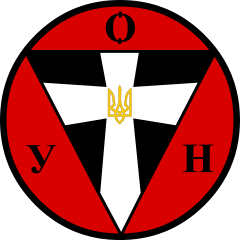More languages
More actions
Organization of Ukrainian Nationalists Організація українських націоналістів | |
|---|---|
 | |
| Founded | 1929 |
| Political orientation | Ukrainian ultranationalism Fascism Anti-communism Anti-Semitism |
The Organization of Ukrainian Nationalists (OUN) was a far-right Ukrainian ultranationalist and fascist group. During the Great Patriotic War, the OUN, led by Stepan Bandera, killed over 100,000 people, including many Jews, Poles and communists.[1]
History[edit | edit source]
Stepan Bandera escaped from prison in Poland after the German invasion in 1939. He tried to take control of the OUN, leading to a split between the OUN-M led by Andrei Melnyk and the OUN-B led by Bandera. Between the German invasion and entry of Soviet forces into Poland, the OUN killed thousands of Jews and Polish soldiers. 800 OUN-B members joined special task forces working with the Wehrmacht.
On 30 June 1941, Yaroslav Stetsko declared a new Ukrainian state under the leadership of Bandera. The OUN and Nazis killed 8,000 Jews in a pogrom in Lviv in early July 1941. They organized more pogroms in western Ukraine later that month, killing around 30,000 more.[2]
In the summer of 1943, 5,000 OUN members helped 10,000 Germans encircle Alexei Fyodorov's partisan army.[3]
War crimes[edit | edit source]
The OUN killed thousands of civilians, including many Jews, in pogroms in Lviv and Rivne in July 1941 and 1942, respectively. They also committed massacres at Khatyn in Belarus and Babin Yar near Kyiv and killed over 100,000 Poles in Volhynia and Galicia.[1]
References[edit | edit source]
- ↑ 1.0 1.1 Deborah L. Armstrong (2022-08-26). "From Nurseries to Nazis: Ukraine’s Terrorist Radicalization of Children" Internationalist 360º. Retrieved 2022-09-02.
- ↑ Hugo Turner (2022-11-05). "History of Fascism in Ukraine Part II: The OUN During World War 2, 1941-1945" Internationalist 360°. Archived from the original on 2022-11-12. Retrieved 2022-11-13.
- ↑ Ludo Martens (1996). Another View of Stalin: 'Collectivization and the 'Ukrainian Holocaust' (p. 93). [PDF] Editions EPO. ISBN 9782872620814
